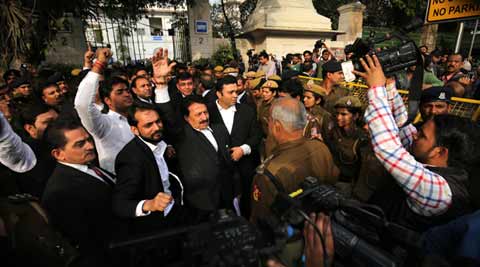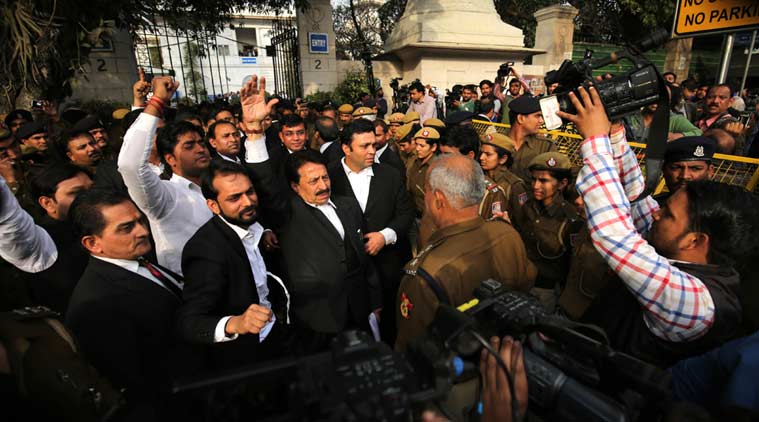Opinion Controlling The Story
Intimidating journalists will result in society losing its eyewitnesses.

 Lawyers outside the Patiala house court after attack on journalists during JNUSU president Kanhaiya Kumar produce, in New Delhi on Feb 15th 2016. (Express photo by Ravi Kanojia)
Lawyers outside the Patiala house court after attack on journalists during JNUSU president Kanhaiya Kumar produce, in New Delhi on Feb 15th 2016. (Express photo by Ravi Kanojia)
An unfamiliar sight it certainly was: A significant number of journalists protesting the attacks on reporters and camerapersons outside the Patiala House court by marching on a spring morning through the heart of Delhi. As they marched, they recalled similar actions taken by men and women before them whenever the media’s freedom of expression was under threat — either because the state had introduced repressive laws (Bihar Press Bill of 1982; Defamation Bill of 1988) or when media professionals were assaulted in the line of duty by random actors, as they were during the Babri Masjid demolition of 1992 or the Gujarat riots of 2002.
Media intimidation is not exactly a new phenomenon. So why was it that this particular episode provoked the response it did? The year, after all, is not even two months old and there have already been several incidents of this kind across the country. These include the shooting dead of the bureau chief of a Hindi daily in Sultanpur, Uttar Pradesh; the beating up of a photojournalist while covering a student protest in Delhi and the terrorising and hounding out of a woman reporter in Bastar, Chhattisgarh just because vigilante mobs did not like what she wrote and the local administration did not care to protect her.
For a country that defines itself as a democracy, India’s record in protecting journalists has been appalling. In 2015, according to the Union government, there were no less than 113 registered cases of “grievous hurt and attack on journalists” that had taken place. So why was it that the Patiala House court incident specifically provoked the protests it did?
Three reasons can be cited for the response. First, that the attacks had taken place three kilometres from the country’s seat of government, and one kilometre from the country’s highest court, indicated the sheer impunity the perpetrators enjoyed.
Second, there could be no denying the deliberately brutal manner in which reporters and camerapersons were set upon by representatives of the Indian justice system, even as the police looked on impassively.
Third, the fact that journalists from across the country were unanimous in condemning the incident indicated that it had transcended its location and had become a rallying point for media freedom.
Physical attack or even issuing the threat of physical attack on the eye-witness/ messenger is ultimately an exercise of power in controlling the narrative. Here, for instance, is a description of another incident when journalists were deliberately intimidated and attacked. It had taken place 24 years ago. “As soon as the pre-programmed assault on the structure commenced, the journalists were subjected to systematic harassment and they were not only prevented from carrying on their duties as chroniclers of the events, but were also instilled with a real fear for their own safety. Photographs and video recordings could have proved damning for the leadership. Photojournalists therefore became recipients of especially violent treatment at the hands of the kar sevaks. They were physically prevented from taking photographs or videotaping the demolition; their equipment was smashed and their exposed films were ripped open and ruined”.
These are lines from the Liberhan Ayodhya commission of inquiry report on what transpired on December 6, 1992, when the Babri mosque was brought to the ground even as the “law enforcing agencies remained silent spectators”.
But these words could just as well have described the events that played out at the Patiala House court last week. If, in the earlier instance, it was a mosque that was in the crosshairs, this time it was Kanhaiya Kumar, a young JNU student framed as a seditionist and deshdrohi (traitor) on plainly fraudulent evidence.
The intimidation of journalists at Patiala House court should not be seen in isolation from the larger debate that is roiling the country: The rise of intolerance and assaults on the right to freedom of expression. If anything, it is an argument for good journalism. In an era when trolls have become philosophers of the age, where television anchors manufacture outrage to keep ahead of the competition, when ministerial pronouncements and policing procedures are based on fake social media content, the need for the honest eyewitness on the ground doing his or her job of telling the story has never been more acutely felt.


